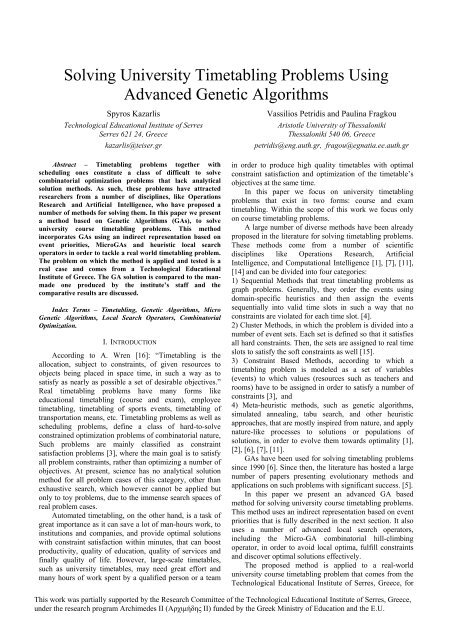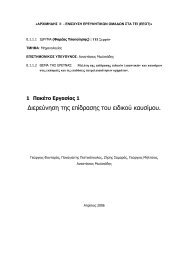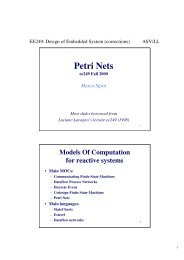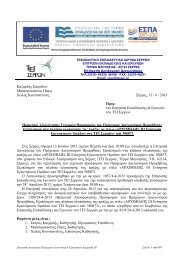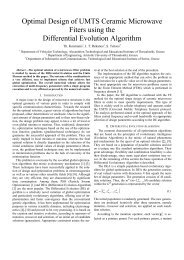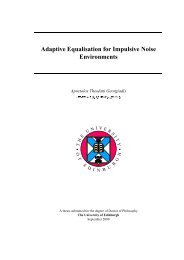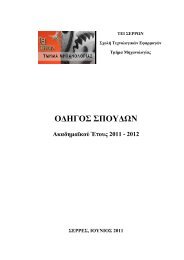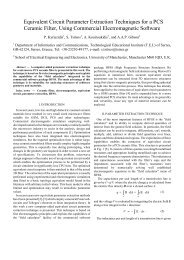Preparation of Papers in a Two-Column Format for the 21st Annual ...
Preparation of Papers in a Two-Column Format for the 21st Annual ...
Preparation of Papers in a Two-Column Format for the 21st Annual ...
You also want an ePaper? Increase the reach of your titles
YUMPU automatically turns print PDFs into web optimized ePapers that Google loves.
Solv<strong>in</strong>g University Timetabl<strong>in</strong>g Problems Us<strong>in</strong>g<br />
Advanced Genetic Algorithms<br />
Spyros Kazarlis<br />
Technological Educational Institute <strong>of</strong> Serres<br />
Serres 621 24, Greece<br />
kazarlis@teiser.gr<br />
Vassilios Petridis and Paul<strong>in</strong>a Fragkou<br />
Aristotle University <strong>of</strong> Thessaloniki<br />
Thessaloniki 540 06, Greece<br />
petridis@eng.auth.gr, fragou@egnatia.ee.auth.gr<br />
Abstract – Timetabl<strong>in</strong>g problems toge<strong>the</strong>r with<br />
schedul<strong>in</strong>g ones constitute a class <strong>of</strong> difficult to solve<br />
comb<strong>in</strong>atorial optimization problems that lack analytical<br />
solution methods. As such, <strong>the</strong>se problems have attracted<br />
researchers from a number <strong>of</strong> discipl<strong>in</strong>es, like Operations<br />
Research and Artificial Intelligence, who have proposed a<br />
number <strong>of</strong> methods <strong>for</strong> solv<strong>in</strong>g <strong>the</strong>m. In this paper we present<br />
a method based on Genetic Algorithms (GAs), to solve<br />
university course timetabl<strong>in</strong>g problems. This method<br />
<strong>in</strong>corporates GAs us<strong>in</strong>g an <strong>in</strong>direct representation based on<br />
event priorities, MicroGAs and heuristic local search<br />
operators <strong>in</strong> order to tackle a real world timetabl<strong>in</strong>g problem.<br />
The problem on which <strong>the</strong> method is applied and tested is a<br />
real case and comes from a Technological Educational<br />
Institute <strong>of</strong> Greece. The GA solution is compared to <strong>the</strong> manmade<br />
one produced by <strong>the</strong> <strong>in</strong>stitute’s staff and <strong>the</strong><br />
comparative results are discussed.<br />
Index Terms – Timetabl<strong>in</strong>g, Genetic Algorithms, Micro<br />
Genetic Algorithms, Local Search Operators, Comb<strong>in</strong>atorial<br />
Optimization.<br />
I. INTRODUCTION<br />
Accord<strong>in</strong>g to A. Wren [16]: “Timetabl<strong>in</strong>g is <strong>the</strong><br />
allocation, subject to constra<strong>in</strong>ts, <strong>of</strong> given resources to<br />
objects be<strong>in</strong>g placed <strong>in</strong> space time, <strong>in</strong> such a way as to<br />
satisfy as nearly as possible a set <strong>of</strong> desirable objectives.”<br />
Real timetabl<strong>in</strong>g problems have many <strong>for</strong>ms like<br />
educational timetabl<strong>in</strong>g (course and exam), employee<br />
timetabl<strong>in</strong>g, timetabl<strong>in</strong>g <strong>of</strong> sports events, timetabl<strong>in</strong>g <strong>of</strong><br />
transportation means, etc. Timetabl<strong>in</strong>g problems as well as<br />
schedul<strong>in</strong>g problems, def<strong>in</strong>e a class <strong>of</strong> hard-to-solve<br />
constra<strong>in</strong>ed optimization problems <strong>of</strong> comb<strong>in</strong>atorial nature,<br />
Such problems are ma<strong>in</strong>ly classified as constra<strong>in</strong>t<br />
satisfaction problems [3], where <strong>the</strong> ma<strong>in</strong> goal is to satisfy<br />
all problem constra<strong>in</strong>ts, ra<strong>the</strong>r than optimiz<strong>in</strong>g a number <strong>of</strong><br />
objectives. At present, science has no analytical solution<br />
method <strong>for</strong> all problem cases <strong>of</strong> this category, o<strong>the</strong>r than<br />
exhaustive search, which however cannot be applied but<br />
only to toy problems, due to <strong>the</strong> immense search spaces <strong>of</strong><br />
real problem cases.<br />
Automated timetabl<strong>in</strong>g, on <strong>the</strong> o<strong>the</strong>r hand, is a task <strong>of</strong><br />
great importance as it can save a lot <strong>of</strong> man-hours work, to<br />
<strong>in</strong>stitutions and companies, and provide optimal solutions<br />
with constra<strong>in</strong>t satisfaction with<strong>in</strong> m<strong>in</strong>utes, that can boost<br />
productivity, quality <strong>of</strong> education, quality <strong>of</strong> services and<br />
f<strong>in</strong>ally quality <strong>of</strong> life. However, large-scale timetables,<br />
such as university timetables, may need great ef<strong>for</strong>t and<br />
many hours <strong>of</strong> work spent by a qualified person or a team<br />
<strong>in</strong> order to produce high quality timetables with optimal<br />
constra<strong>in</strong>t satisfaction and optimization <strong>of</strong> <strong>the</strong> timetable’s<br />
objectives at <strong>the</strong> same time.<br />
In this paper we focus on university timetabl<strong>in</strong>g<br />
problems that exist <strong>in</strong> two <strong>for</strong>ms: course and exam<br />
timetabl<strong>in</strong>g. With<strong>in</strong> <strong>the</strong> scope <strong>of</strong> this work we focus only<br />
on course timetabl<strong>in</strong>g problems.<br />
A large number <strong>of</strong> diverse methods have been already<br />
proposed <strong>in</strong> <strong>the</strong> literature <strong>for</strong> solv<strong>in</strong>g timetabl<strong>in</strong>g problems.<br />
These methods come from a number <strong>of</strong> scientific<br />
discipl<strong>in</strong>es like Operations Research, Artificial<br />
Intelligence, and Computational Intelligence [1], [7], [11],<br />
[14] and can be divided <strong>in</strong>to four categories:<br />
1) Sequential Methods that treat timetabl<strong>in</strong>g problems as<br />
graph problems. Generally, <strong>the</strong>y order <strong>the</strong> events us<strong>in</strong>g<br />
doma<strong>in</strong>-specific heuristics and <strong>the</strong>n assign <strong>the</strong> events<br />
sequentially <strong>in</strong>to valid time slots <strong>in</strong> such a way that no<br />
constra<strong>in</strong>ts are violated <strong>for</strong> each time slot. [4].<br />
2) Cluster Methods, <strong>in</strong> which <strong>the</strong> problem is divided <strong>in</strong>to a<br />
number <strong>of</strong> event sets. Each set is def<strong>in</strong>ed so that it satisfies<br />
all hard constra<strong>in</strong>ts. Then, <strong>the</strong> sets are assigned to real time<br />
slots to satisfy <strong>the</strong> s<strong>of</strong>t constra<strong>in</strong>ts as well [15].<br />
3) Constra<strong>in</strong>t Based Methods, accord<strong>in</strong>g to which a<br />
timetabl<strong>in</strong>g problem is modeled as a set <strong>of</strong> variables<br />
(events) to which values (resources such as teachers and<br />
rooms) have to be assigned <strong>in</strong> order to satisfy a number <strong>of</strong><br />
constra<strong>in</strong>ts [3], and<br />
4) Meta-heuristic methods, such as genetic algorithms,<br />
simulated anneal<strong>in</strong>g, tabu search, and o<strong>the</strong>r heuristic<br />
approaches, that are mostly <strong>in</strong>spired from nature, and apply<br />
nature-like processes to solutions or populations <strong>of</strong><br />
solutions, <strong>in</strong> order to evolve <strong>the</strong>m towards optimality [1],<br />
[2], [6], [7], [11].<br />
GAs have been used <strong>for</strong> solv<strong>in</strong>g timetabl<strong>in</strong>g problems<br />
s<strong>in</strong>ce 1990 [6]. S<strong>in</strong>ce <strong>the</strong>n, <strong>the</strong> literature has hosted a large<br />
number <strong>of</strong> papers present<strong>in</strong>g evolutionary methods and<br />
applications on such problems with significant success. [5].<br />
In this paper we present an advanced GA based<br />
method <strong>for</strong> solv<strong>in</strong>g university course timetabl<strong>in</strong>g problems.<br />
This method uses an <strong>in</strong>direct representation based on event<br />
priorities that is fully described <strong>in</strong> <strong>the</strong> next section. It also<br />
uses a number <strong>of</strong> advanced local search operators,<br />
<strong>in</strong>clud<strong>in</strong>g <strong>the</strong> Micro-GA comb<strong>in</strong>atorial hill-climb<strong>in</strong>g<br />
operator, <strong>in</strong> order to avoid local optima, fulfill constra<strong>in</strong>ts<br />
and discover optimal solutions effectively.<br />
The proposed method is applied to a real-world<br />
university course timetabl<strong>in</strong>g problem that comes from <strong>the</strong><br />
Technological Educational Institute <strong>of</strong> Serres, Greece, <strong>for</strong><br />
This work was partially supported by <strong>the</strong> Research Committee <strong>of</strong> <strong>the</strong> Technological Educational Institute <strong>of</strong> Serres, Greece,<br />
under <strong>the</strong> research program Archimedes II (Αρχιµήδης ΙΙ) funded by <strong>the</strong> Greek M<strong>in</strong>istry <strong>of</strong> Education and <strong>the</strong> E.U.
which a man made solution was also available, and has<br />
been used to compare and evaluate <strong>the</strong> results <strong>of</strong> <strong>the</strong> GA<br />
method.<br />
The paper is organized as follows: Section II analyzes<br />
university course timetabl<strong>in</strong>g and <strong>the</strong> specific real case that<br />
is used as a benchmark. Section III presents <strong>the</strong> advanced<br />
GA method and all advanced operators used by it. Section<br />
IV presents <strong>the</strong> simulation results and f<strong>in</strong>ally conclusions<br />
are presented <strong>in</strong> Section V.<br />
II. UNIVERSITY COURSE TIMETABLING<br />
In general a university course timetabl<strong>in</strong>g problem<br />
consists <strong>in</strong> f<strong>in</strong>d<strong>in</strong>g <strong>the</strong> exact time allocation with<strong>in</strong> a<br />
limited time period (e.g. a week), <strong>of</strong> a number <strong>of</strong> events<br />
(courses-lectures) and also assign to <strong>the</strong>m a number <strong>of</strong><br />
resources (a teacher, a room, etc.) <strong>in</strong> such a way that a<br />
number <strong>of</strong> constra<strong>in</strong>ts are satisfied. Usually courses are<br />
organized <strong>in</strong> a number <strong>of</strong> semesters (e.g. 8). The<br />
constra<strong>in</strong>ts that have to be satisfied by a timetable are<br />
usually divided <strong>in</strong>to two categories: hard constra<strong>in</strong>ts and<br />
s<strong>of</strong>t ones.<br />
Hard constra<strong>in</strong>ts are those constra<strong>in</strong>ts that must be<br />
rigidly fulfilled. Examples <strong>of</strong> such constra<strong>in</strong>ts are:<br />
- No resource (teacher, student, room, etc.) may be<br />
assigned to different events at <strong>the</strong> same time.<br />
- Events <strong>of</strong> <strong>the</strong> same semester must not be assigned at <strong>the</strong><br />
same time slot (<strong>in</strong> order <strong>for</strong> <strong>the</strong> students <strong>of</strong> <strong>the</strong> semester to<br />
be able to attend all semester lessons).<br />
- Assigned resources to an event (e.g. teachers) must<br />
belong to <strong>the</strong> set <strong>of</strong> valid resources <strong>for</strong> that event (e.g. only<br />
specific teachers can teach a specific course).<br />
On <strong>the</strong> o<strong>the</strong>r hand, s<strong>of</strong>t constra<strong>in</strong>ts are those that it is<br />
desirable to be fulfilled to <strong>the</strong> possible extent, but are not<br />
fully essential <strong>for</strong> a valid solution. There<strong>for</strong>e, s<strong>of</strong>t<br />
constra<strong>in</strong>ts can also be seen as optimization objectives <strong>for</strong><br />
<strong>the</strong> search algorithm. Examples <strong>of</strong> such constra<strong>in</strong>ts are:<br />
- Schedule an event with<strong>in</strong> a particular “w<strong>in</strong>dow” <strong>of</strong> <strong>the</strong><br />
whole period (e.g. on even<strong>in</strong>gs).<br />
- M<strong>in</strong>imize time gaps or travel times between adjacent<br />
lectures <strong>of</strong> <strong>the</strong> same teacher.<br />
The specific problem we used <strong>in</strong> this work comes from<br />
<strong>the</strong> Technological Educational Institute <strong>of</strong> Serres, Greece,<br />
and <strong>in</strong>volves <strong>the</strong> weekly schedul<strong>in</strong>g <strong>of</strong> all courses <strong>of</strong> <strong>the</strong><br />
Department <strong>of</strong> In<strong>for</strong>matics & Communications <strong>of</strong> this<br />
Institute. The specifications <strong>of</strong> this problem are shown <strong>in</strong><br />
Table I.<br />
TABLE I<br />
TIMETABLING PROBLEM SPECIFICATIONS<br />
No. Description Quantity<br />
1 No <strong>of</strong> courses 71<br />
2 No <strong>of</strong> different lectures 187<br />
3 No <strong>of</strong> scheduled events 192<br />
4 No <strong>of</strong> semesters 7<br />
5 Lecture types (<strong>the</strong>ory / lab practice) 2<br />
6 No <strong>of</strong> teachers 82<br />
7 No <strong>of</strong> rooms 17<br />
8 No <strong>of</strong> days 5<br />
9 No <strong>of</strong> time slots with<strong>in</strong> a day 13<br />
In Table I <strong>the</strong> value <strong>of</strong> “13” <strong>for</strong> <strong>the</strong> field “time slots<br />
with<strong>in</strong> a day” just denotes <strong>the</strong> possible “start<strong>in</strong>g periods” <strong>of</strong><br />
each class (from 8:00 am to 20:00 pm) and not complete<br />
time slots that can accommodate equal number <strong>of</strong><br />
consequent classes. As different lectures have different<br />
durations (2..4 hours), <strong>the</strong> real number <strong>of</strong> consequent<br />
classes that can be scheduled with<strong>in</strong> a day depends on <strong>the</strong><br />
specific set <strong>of</strong> classes chosen and <strong>the</strong>ir durations.<br />
The hard constra<strong>in</strong>ts considered <strong>for</strong> this problem are<br />
shown <strong>in</strong> Table II.<br />
TABLE II<br />
HARD CONSTRAINTS OF THE TIMETABLING PROBLEM<br />
No Hard Constra<strong>in</strong>t<br />
1 No resource (teacher or room) may be assigned to<br />
different events at <strong>the</strong> same time<br />
2 Events <strong>of</strong> <strong>the</strong> same semester must not be assigned<br />
at <strong>the</strong> same time slot when both events are <strong>of</strong> type<br />
“<strong>the</strong>ory” or when one event is “<strong>the</strong>ory” and one<br />
event is “lab practice”. Same-semester events can<br />
run concurrently only if <strong>the</strong>y are both <strong>of</strong> type “lab<br />
practice”, as <strong>for</strong> each course 4..6 “lab practice”<br />
classes are scheduled with<strong>in</strong> <strong>the</strong> week, each<br />
attended by a different group <strong>of</strong> students.<br />
3 There is a maximum number <strong>of</strong> time slots per day<br />
(13), that may not be exceeded<br />
4 Each lecture may be held <strong>in</strong> a room belong<strong>in</strong>g to a<br />
specific set <strong>of</strong> valid rooms <strong>for</strong> <strong>the</strong> lecture<br />
5 Each room may have its own availability schedule<br />
6 Each lecture may be assigned to a teacher that<br />
belongs to a specific set <strong>of</strong> teachers that can deliver<br />
<strong>the</strong> lecture.<br />
7 Specific lectures must be rigidly assigned to<br />
specific teachers.<br />
8 Classes <strong>of</strong> type “<strong>the</strong>ory” need one teacher while<br />
classes <strong>of</strong> type “lab practice” need 2 teachers.<br />
The s<strong>of</strong>t constra<strong>in</strong>ts considered <strong>for</strong> this problem are<br />
shown <strong>in</strong> Table III.<br />
TABLE III<br />
SOFT CONSTRAINTS OF THE TIMETABLING PROBLEM<br />
No S<strong>of</strong>t Constra<strong>in</strong>t<br />
1 Every teacher has it own availability schedule or<br />
submits a plan with desirable time periods that suit<br />
him best<br />
2 Every teacher has a m<strong>in</strong>imum limit and a maximum<br />
limit <strong>for</strong> man-hour work per week<br />
3 If a class is broken <strong>in</strong> more than one noncontiguous<br />
lectures with<strong>in</strong> a week, a specific<br />
number <strong>of</strong> days must be left between <strong>the</strong>se lectures.<br />
4 M<strong>in</strong>imize <strong>the</strong> travel time <strong>of</strong> teachers and students<br />
between rooms with<strong>in</strong> <strong>the</strong> campus<br />
5 M<strong>in</strong>imize <strong>the</strong> time gaps with<strong>in</strong> <strong>the</strong> schedule <strong>of</strong> each<br />
teacher<br />
6 M<strong>in</strong>imize <strong>the</strong> time gaps with<strong>in</strong> <strong>the</strong> schedule <strong>of</strong> each<br />
room
There are three reasons <strong>for</strong> select<strong>in</strong>g <strong>the</strong> specific case<br />
as a benchmark. Firstly because <strong>the</strong> authors had access to<br />
<strong>the</strong> real constra<strong>in</strong>ts considered <strong>for</strong> develop<strong>in</strong>g <strong>the</strong> manmade<br />
solution to <strong>the</strong> problem, <strong>in</strong> order to set-up <strong>the</strong><br />
timetabl<strong>in</strong>g problem on a realistic basis. Secondly because<br />
<strong>the</strong> authors had easy access to man-made solutions <strong>for</strong> this<br />
problem, and could easily make comparisons. The third<br />
reason was <strong>the</strong> fact that <strong>the</strong> specific problem is not an easy<br />
one to solve, and thus can serve as a demand<strong>in</strong>g benchmark<br />
<strong>for</strong> develop<strong>in</strong>g an efficient optimization algorithm.<br />
The difficulty <strong>of</strong> <strong>the</strong> chosen problem case is justified<br />
by <strong>the</strong> follow<strong>in</strong>g facts:<br />
a) The problem has two types <strong>of</strong> lectures (“<strong>the</strong>ory” and<br />
“lab practice”) with diverse characteristics and constra<strong>in</strong>ts.<br />
In fact nearly every course has a “<strong>the</strong>ory” lesson and a “lab<br />
practice” one. Lessons <strong>of</strong> type “<strong>the</strong>ory” demand one<br />
teacher, while lessons <strong>of</strong> type “lab practice” demand two<br />
teachers.<br />
b) The timetable has too few rooms (only 17) that have to<br />
accommodate all taught lessons, a fact that makes <strong>the</strong><br />
timetable very tight. Some <strong>of</strong> <strong>the</strong> rooms are laboratories<br />
designed <strong>for</strong> “lab practice” classes, and o<strong>the</strong>rs are lecture<br />
rooms. In practice, all 9 laboratories are occupied by<br />
classes, <strong>for</strong> <strong>the</strong> full number <strong>of</strong> periods per day and all five<br />
days with only m<strong>in</strong>or time-gaps.<br />
c) Specific classes may be taught <strong>in</strong> specific rooms. Each<br />
“<strong>the</strong>ory” class can be assigned to any <strong>of</strong> <strong>the</strong> 8 lecture<br />
rooms, but “lab” classes must be assigned to specific “lab”<br />
rooms.<br />
d) There is a large number <strong>of</strong> teachers, each <strong>of</strong> which has<br />
its’ own m<strong>in</strong>imum and maximum hour limits per week, and<br />
<strong>the</strong> ability to teach <strong>in</strong> a limited set <strong>of</strong> classes.<br />
III. THE ADVANCED GA IMPLEMENTATION<br />
In order to solve <strong>the</strong> timetabl<strong>in</strong>g problem described <strong>in</strong><br />
<strong>the</strong> previous section, we have developed an optimization<br />
method based on Genetic Algorithms (GAs) that<br />
<strong>in</strong>corporate a number <strong>of</strong> advanced techniques and doma<strong>in</strong><br />
specific local search operators.<br />
The first th<strong>in</strong>g to consider was <strong>the</strong> representation<br />
method to use <strong>in</strong> order to encode a timetable solution <strong>in</strong>to<br />
an encoded <strong>for</strong>m or chromosome, suitable <strong>for</strong> apply<strong>in</strong>g <strong>the</strong><br />
genetic operators. Accord<strong>in</strong>g to <strong>the</strong> literature two different<br />
approaches are used: “direct” and “<strong>in</strong>direct” ones.<br />
A “direct” representation [2] directly encodes all event<br />
attributes (day, time slot, teacher, room, etc.) <strong>for</strong> all events.<br />
Thus, <strong>in</strong> <strong>the</strong>se cases <strong>the</strong> GA has to decide <strong>for</strong> all timetable<br />
parameters and deliver <strong>the</strong> complete and constra<strong>in</strong>t free<br />
schedule. Follow<strong>in</strong>g this pr<strong>in</strong>ciple results <strong>in</strong> a very large<br />
search space where solutions that satisfy all constra<strong>in</strong>ts<br />
seem like “needles <strong>in</strong> a haystack”. Moreover, directly<br />
encoded solutions, that undergo <strong>the</strong> genetic operators,<br />
frequently result <strong>in</strong> <strong>in</strong>valid solutions, that have to be<br />
“repaired” or handled <strong>in</strong> some manner.<br />
In “<strong>in</strong>direct” representations [11] <strong>the</strong> encoded solution<br />
(chromosome) usually represents an ordered list <strong>of</strong> events,<br />
which are placed <strong>in</strong>to <strong>the</strong> timetable accord<strong>in</strong>g to some predef<strong>in</strong>ed<br />
method, or “timetable builder”. The timetable<br />
builder can use any comb<strong>in</strong>ation <strong>of</strong> heuristics and local<br />
search to place events <strong>in</strong>to <strong>the</strong> timetable, while observ<strong>in</strong>g<br />
<strong>the</strong> problem’s constra<strong>in</strong>ts.<br />
For <strong>the</strong> GA implementation <strong>of</strong> this work we have<br />
chosen an “<strong>in</strong>direct” representation that encodes 4 fields<br />
<strong>for</strong> each event <strong>in</strong>to <strong>the</strong> chromosome:<br />
a) Day to allocate <strong>the</strong> event<br />
b) Teachers (1 or 2) to assign to <strong>the</strong> event<br />
c) Room where <strong>the</strong> event will be held<br />
d) Priority to allocate <strong>the</strong> event with<strong>in</strong> <strong>the</strong> day.<br />
Of course all fields are first encoded as <strong>in</strong>tegers and <strong>the</strong>n<br />
entered <strong>in</strong>to <strong>the</strong> chromosome as b<strong>in</strong>ary numbers.<br />
When GA produces such a solution, it first decodes it<br />
to ga<strong>in</strong> <strong>the</strong>se four fields <strong>for</strong> every event <strong>in</strong> <strong>the</strong> schedule.<br />
Then it <strong>in</strong>vokes a “timetable builder” rout<strong>in</strong>e called<br />
“timetabler” that works as follows:<br />
1. It separates events <strong>in</strong>to clusters, one <strong>for</strong> each day.<br />
2. For every cluster, it sorts <strong>the</strong> events accord<strong>in</strong>g to <strong>the</strong>ir<br />
“priority” values and <strong>in</strong> ascend<strong>in</strong>g order (small values<br />
mean high priority and are placed first).<br />
3. It takes <strong>the</strong> first event <strong>in</strong> <strong>the</strong> cluster (higher priority),<br />
marks it as taken, and tries to place it <strong>in</strong>to <strong>the</strong> schedule <strong>of</strong><br />
<strong>the</strong> particular day.<br />
4. Start<strong>in</strong>g from time slot 1 it places <strong>the</strong> event and checks if<br />
any constra<strong>in</strong>ts are violated. If not <strong>the</strong> allocation is fixed<br />
and <strong>the</strong> algorithm moves on to <strong>the</strong> next event <strong>in</strong> <strong>the</strong> cluster.<br />
5. If any constra<strong>in</strong>ts are violated, it tries to allocate <strong>the</strong><br />
event <strong>in</strong>to subsequent time slots, until all constra<strong>in</strong>ts are<br />
satisfied.<br />
6. If <strong>the</strong>re exists no time slot <strong>for</strong> which all constra<strong>in</strong>ts are<br />
satisfied, <strong>the</strong> event is marked to violate <strong>the</strong> “maximum time<br />
slots per day exceeded” constra<strong>in</strong>t (constra<strong>in</strong>t no 3 from<br />
Table II).<br />
7. The algorithm cont<strong>in</strong>ues with <strong>the</strong> next event <strong>in</strong> <strong>the</strong> list.<br />
When all events have been processed, <strong>the</strong> “timetabler”<br />
moves to <strong>the</strong> next cluster (day), and this is repeated <strong>for</strong> all<br />
days <strong>in</strong> <strong>the</strong> schedule.<br />
The “timetabler” manages to satisfy hard constra<strong>in</strong>ts<br />
1,2,5,7 and 8 <strong>of</strong> Table II, while all o<strong>the</strong>r constra<strong>in</strong>ts are left<br />
to be satisfied by <strong>the</strong> GA.<br />
After “timetabler” has produced <strong>the</strong> timetable, it is<br />
evaluated through a fitness function that analyzes <strong>the</strong><br />
solution and calculates its overall fitness value as a sum <strong>of</strong><br />
weighted scores and penalties <strong>for</strong> all constra<strong>in</strong>ts (hard and<br />
s<strong>of</strong>t) as well as objectives. The fitness function used <strong>in</strong> this<br />
GA implementation is <strong>of</strong> <strong>the</strong> <strong>for</strong>m:<br />
s<strong>of</strong>t<br />
F ( x)<br />
= ∑ w<br />
s<br />
× ( ) +<br />
h<br />
∑ ×<br />
hard<br />
i<br />
P<br />
i<br />
x w<br />
i<br />
P<br />
i<br />
( x)<br />
(1)<br />
i= 1..6<br />
i=<br />
3,4, 6<br />
s<strong>of</strong>t<br />
where x is <strong>the</strong> timetable under evaluation, P i (x) is a<br />
measure <strong>of</strong> violation <strong>of</strong> <strong>the</strong> i th s<strong>of</strong>t constra<strong>in</strong>t, P hard i (x) is a<br />
measure <strong>of</strong> violation <strong>of</strong> <strong>the</strong> i th<br />
s<br />
hard constra<strong>in</strong>t, w i is a<br />
weight factor <strong>for</strong> <strong>the</strong> i th s<strong>of</strong>t constra<strong>in</strong>t, and w h i is a weight<br />
factor <strong>for</strong> <strong>the</strong> i th hard constra<strong>in</strong>t. This function must be<br />
m<strong>in</strong>imized.<br />
From <strong>the</strong> above it is clear that, some <strong>of</strong> <strong>the</strong> problem’s<br />
constra<strong>in</strong>ts, are handled by <strong>the</strong> “timetabler” dur<strong>in</strong>g <strong>the</strong><br />
construction <strong>of</strong> <strong>the</strong> complete solution from <strong>the</strong> genetically
produced abstract solution. The rest <strong>of</strong> <strong>the</strong> constra<strong>in</strong>ts are<br />
handled us<strong>in</strong>g a penalty function that is composed as a<br />
weighted sum <strong>of</strong> penalty terms, each <strong>of</strong> which corresponds<br />
to a measure <strong>of</strong> violation <strong>of</strong> each constra<strong>in</strong>t. Moreover, s<strong>of</strong>t<br />
constra<strong>in</strong>ts could also be seen as optimization objectives<br />
that have to be optimized by <strong>the</strong> algorithm to <strong>the</strong> possible<br />
extent.<br />
The next th<strong>in</strong>g to consider was <strong>the</strong> blend <strong>of</strong> genetic<br />
operators to <strong>in</strong>corporate <strong>in</strong>to <strong>the</strong> GA method, <strong>in</strong> order to<br />
achieve maximum optimization per<strong>for</strong>mance. To do this<br />
we first considered standard operators as well as general<br />
purpose comb<strong>in</strong>atorial operators. The operators and <strong>the</strong>ir<br />
parameters considered <strong>for</strong> <strong>in</strong>corporation are shown <strong>in</strong><br />
Table IV.<br />
TABLE IV<br />
STANDARD OPERATORS AND PARAMETERS CONSIDERED<br />
No Operator<br />
Parameter<br />
1.1 Crossover 20-po<strong>in</strong>t<br />
1.2 Crossover Uni<strong>for</strong>m<br />
2.1 Mutation prob=0.005<br />
2.2 Mutation prob=0.01<br />
3.1 W<strong>in</strong>dow Mutation operator prob=0.1<br />
3.2 W<strong>in</strong>dow Mutation operator prob=0.3<br />
4.1 Swap Chromosome operator prob=0.1<br />
4.2 Swap Chromosome operator prob=0.3<br />
5.1 Swap Bit operator prob=0.1<br />
5.2 Swap Bit operator prob=0.3<br />
6.1 Swap W<strong>in</strong>dow operator prob=0.1<br />
6.2 Swap W<strong>in</strong>dow operator prob=0.3<br />
7.1 Random Genotype operator prob=0.1<br />
7.2 Random Genotype operator prob=0.3<br />
8.1 Mutate Chromosome operator prob=0.1<br />
8.2 Mutate Chromosome operator prob=0.3<br />
9 Bit Swap-Mutate Hill Climb<strong>in</strong>g oper. prob=0.5<br />
10 W<strong>in</strong>dow Swap Hill Climb<strong>in</strong>g oper. prob=0.5<br />
11.1 Vary<strong>in</strong>g Fitness Function L<strong>in</strong>ear<br />
11.2 Vary<strong>in</strong>g Fitness Function Square<br />
11.3 Vary<strong>in</strong>g Fitness Function Exponential<br />
12.1 GA Population 100<br />
12.2 GA Population 200<br />
13 MicroGA Comb<strong>in</strong>atorial Hill Climb. prob=1.0<br />
Operators 3 (3.1) through 10 are described <strong>in</strong> [9]. The<br />
Vary<strong>in</strong>g Fitness Function technique is described <strong>in</strong> [12].<br />
Operator 13 is described <strong>in</strong> [8], [10].<br />
The standard GA setup employed Roulette Wheel<br />
Parent Selection, population <strong>of</strong> 50 solutions, standard 5-<br />
po<strong>in</strong>t crossover operator, bit mutation operator with a<br />
probability <strong>of</strong> 0.001 per bit, elitism, replacement <strong>of</strong> <strong>the</strong><br />
whole population <strong>of</strong> parents with <strong>of</strong>fspr<strong>in</strong>g, fitness scal<strong>in</strong>g<br />
and a generation limit <strong>of</strong> 5000 generations. The operators<br />
(and <strong>the</strong>ir parameters) <strong>of</strong> Table IV where tested <strong>in</strong> order to<br />
decide whe<strong>the</strong>r to adopt <strong>the</strong>m or not <strong>in</strong> <strong>the</strong> f<strong>in</strong>al algorithm.<br />
The correspond<strong>in</strong>g simulation results are presented <strong>in</strong><br />
section IV.<br />
Due to <strong>the</strong> specific nature and difficulty <strong>of</strong> <strong>the</strong> problem<br />
we have also considered doma<strong>in</strong> specific hill climb<strong>in</strong>g<br />
operators that are applied only to <strong>the</strong> best solution <strong>of</strong> each<br />
generation. These operators are:<br />
a) Change Day Hill Climb<strong>in</strong>g Operator<br />
This operator selects an event at random and changes<br />
its encoded day-<strong>of</strong>-allocation field, assign<strong>in</strong>g to it all day<br />
values sequentially, except from <strong>the</strong> orig<strong>in</strong>al day value.<br />
Every time <strong>the</strong> result<strong>in</strong>g timetable is evaluated and if it<br />
scores better than <strong>the</strong> orig<strong>in</strong>al <strong>the</strong>n <strong>the</strong> change is kept,<br />
o<strong>the</strong>rwise <strong>the</strong> old day value is restored.<br />
b) Fix Teacher Hill Climb<strong>in</strong>g Operator<br />
This operator f<strong>in</strong>ds all events with teacher-class<br />
constra<strong>in</strong>t violations (constra<strong>in</strong>t 6 <strong>of</strong> Table II) and selects<br />
one such event at random. Then it changes <strong>the</strong> encoded<br />
teacher-to-allocate field, assign<strong>in</strong>g to it all valid teachers<br />
sequentially, except from <strong>the</strong> orig<strong>in</strong>al one. Every time <strong>the</strong><br />
result<strong>in</strong>g timetable is evaluated and if it evaluates better<br />
than <strong>the</strong> orig<strong>in</strong>al, <strong>the</strong>n <strong>the</strong> change is kept, o<strong>the</strong>rwise <strong>the</strong> old<br />
teacher value is restored.<br />
c) Fix Room Hill Climb<strong>in</strong>g Operator<br />
This operator f<strong>in</strong>ds all events with room-class<br />
constra<strong>in</strong>t violations (constra<strong>in</strong>t 4 <strong>of</strong> Table II) and selects<br />
one such event at random. Then it changes <strong>the</strong> encoded<br />
room-to-allocate field, assign<strong>in</strong>g to it all valid rooms<br />
sequentially, except from <strong>the</strong> orig<strong>in</strong>al one. Every time <strong>the</strong><br />
result<strong>in</strong>g timetable is evaluated, and if it evaluates better<br />
than <strong>the</strong> orig<strong>in</strong>al, <strong>the</strong>n <strong>the</strong> change is kept, o<strong>the</strong>rwise <strong>the</strong> old<br />
room value is restored.<br />
d) Fix Day Hill Climb<strong>in</strong>g Operator<br />
This operator f<strong>in</strong>ds all events that are allocated beyond<br />
<strong>the</strong> maximum time-slot per day limit (constra<strong>in</strong>t 3 <strong>of</strong> Table<br />
II), and selects one such event at random. Then it changes<br />
<strong>the</strong> encoded day-<strong>of</strong>-allocation field, assign<strong>in</strong>g to it all day<br />
values sequentially, except from <strong>the</strong> orig<strong>in</strong>al one. Every<br />
time <strong>the</strong> result<strong>in</strong>g timetable is evaluated, and if it evaluates<br />
better than <strong>the</strong> orig<strong>in</strong>al, <strong>the</strong>n <strong>the</strong> change is kept, o<strong>the</strong>rwise<br />
<strong>the</strong> old day value is restored.<br />
It is obvious that <strong>the</strong>se four operators are specifically<br />
designed to give <strong>the</strong> GA <strong>the</strong> ability to fulfill all three hard<br />
constra<strong>in</strong>ts (constra<strong>in</strong>ts 3,4,6 <strong>of</strong> Table II) that are not<br />
satisfied automatically by <strong>the</strong> “timetabler”. The<br />
effectiveness <strong>of</strong> <strong>the</strong>se operators has been also tested and<br />
simulation results are reported <strong>in</strong> section IV.<br />
IV. SIMULATION RESULTS<br />
In order to decide which operators <strong>of</strong> Table IV to<br />
adopt, one should run simulations <strong>for</strong> all parameter<br />
comb<strong>in</strong>ations. However <strong>the</strong> number <strong>of</strong> comb<strong>in</strong>ations<br />
(nearly 420,000) is prohibitive <strong>for</strong> exhaustive evaluation.<br />
Thus, we have applied an “elitism-like” technique <strong>in</strong> order<br />
to reduce <strong>the</strong> number <strong>of</strong> simulations needed. This<br />
technique goes as follows:<br />
First we conducted a simulation experiment <strong>for</strong> <strong>the</strong><br />
standard GA setup described <strong>in</strong> <strong>the</strong> previous section. The<br />
experiment consisted <strong>of</strong> 10 <strong>in</strong>dependent runs. After <strong>the</strong><br />
completion <strong>of</strong> <strong>the</strong> runs we calculated three statistical<br />
figures: <strong>the</strong> overall best solution quality achieved, <strong>the</strong><br />
overall worst solution quality achieved and <strong>the</strong> average
solution quality achieved, throughout <strong>the</strong> 10 runs. Then,<br />
we added <strong>the</strong> first operator setup <strong>of</strong> Table IV to <strong>the</strong><br />
standard GA setup and ano<strong>the</strong>r simulation round <strong>of</strong> 10 runs<br />
was launched. The results were compared to those <strong>of</strong> <strong>the</strong><br />
standard setup via <strong>the</strong> three statistical figures mentioned<br />
above. If <strong>the</strong> new setup was found to have better<br />
per<strong>for</strong>mance than <strong>the</strong> orig<strong>in</strong>al, <strong>the</strong>n <strong>the</strong> new setup was<br />
adopted as <strong>the</strong> “best-so-far” setup. O<strong>the</strong>rwise <strong>the</strong> tested<br />
setup was ignored. With this method only 25 simulations<br />
<strong>of</strong> 10 runs each are needed to evaluate <strong>the</strong> operators (and<br />
<strong>the</strong>ir parameters) <strong>of</strong> Table IV. Of course <strong>the</strong> validity <strong>of</strong> this<br />
method is based on <strong>the</strong> assumption that <strong>the</strong> operators are<br />
more or less <strong>in</strong>dependent <strong>of</strong> each o<strong>the</strong>r, a fact that is pretty<br />
much close to truth, and is also justified by experimental<br />
results.<br />
The simulation results <strong>for</strong> <strong>the</strong> operators <strong>of</strong> Table IV are<br />
shown <strong>in</strong> Table V, where all adopted setups are marked<br />
with two asterisks “*” and are displayed <strong>in</strong> bold typeface.<br />
TABLE V<br />
SIMULATION RESULTS FOR STANDARD OPERATORS AND PARAMETERS<br />
Setup Mean Qual. Best Qual. Worst Qual.<br />
Standard 74192 61087 97073<br />
1.1 72387 52087 91080<br />
* 1.2 * 67980 60102 76077<br />
2.1 72482 57079 83072<br />
2.2 81798 65113 93120<br />
3.1 61486 50092 76090<br />
* 3.2 * 61596 44118 78093<br />
* 4.1 * 66387 42095 83094<br />
4.2 65190 52094 76094<br />
5.1 70192 56091 83101<br />
5.2 65991 53101 83085<br />
6.1 65992 54092 88094<br />
6.2 65288 56094 76072<br />
7.1 71793 61117 80096<br />
7.2 76979 52102 89087<br />
* 8.1 * 53590 45093 65079<br />
8.2 59789 45097 77103<br />
9 68581 46085 92080<br />
10 58389 48098 71101<br />
11.1 50370 39078 67089<br />
* 11.2 * 52359 37093 63036<br />
11.3 57796 47764 69626<br />
12.1 53388 39084 88098<br />
* 12.2 * 42089 26104 59082<br />
* 13 * 29882 23082 35078<br />
From Table V it is clear that <strong>the</strong> operators that exhibited<br />
best per<strong>for</strong>mance and were adopted <strong>in</strong> <strong>the</strong> GA scheme were<br />
<strong>the</strong> follow<strong>in</strong>g:<br />
1. Uni<strong>for</strong>m Crossover<br />
2. W<strong>in</strong>dow Mutation operator with a probability <strong>of</strong> 0.3<br />
3. Swap Chromosome operator with a probability <strong>of</strong> 0.1<br />
4. Mutate Chromosome operator with a probability <strong>of</strong> 0.1<br />
5. Vary<strong>in</strong>g fitness Function with square <strong>in</strong>crease.<br />
6. GA population <strong>of</strong> 200 genotypes, and<br />
7. Micro GA comb<strong>in</strong>atorial hill climb<strong>in</strong>g operator.<br />
By add<strong>in</strong>g <strong>the</strong>se operators to <strong>the</strong> standard GA scheme<br />
we have managed to evolve <strong>the</strong> best overall solution from<br />
<strong>the</strong> value <strong>of</strong> 61087 <strong>for</strong> <strong>the</strong> standard setup, down to <strong>the</strong><br />
value <strong>of</strong> 23082 <strong>for</strong> <strong>the</strong> advanced setup. A quality <strong>of</strong> 61087<br />
means that <strong>the</strong> solution roughly violates 60 hard<br />
constra<strong>in</strong>ts, while at 23082 only 22 hard constra<strong>in</strong>ts are<br />
violated.<br />
The next step was to test <strong>the</strong> effectiveness <strong>of</strong> <strong>the</strong><br />
doma<strong>in</strong> specific hill climb<strong>in</strong>g operators described <strong>in</strong> <strong>the</strong><br />
previous section. For this reason four (4) more simulation<br />
experiments were conducted. Each experiment<br />
<strong>in</strong>corporated one <strong>of</strong> <strong>the</strong> four doma<strong>in</strong> specific operators.<br />
Aga<strong>in</strong> 10 runs were executed <strong>for</strong> each experiment and each<br />
time <strong>the</strong> results were compared to <strong>the</strong> best-so-far results.<br />
When an operator was found to enhance <strong>the</strong> per<strong>for</strong>mance<br />
<strong>of</strong> <strong>the</strong> GA optimizer, it was adopted. The simulation results<br />
<strong>for</strong> <strong>the</strong>se operators are shown <strong>in</strong> Table VI.<br />
TABLE VI<br />
SIMULATION RESULTS FOR DOMAIN SPECIFIC OPERATORS<br />
Operator Mean Qual. Best Qual. Worst Qual.<br />
Change Day 20978 14568 29047<br />
Fix Teacher 18286 12533 29047<br />
Fix Room 13462 9577 23035<br />
Fix Day 70056 3107 11606<br />
As it is clear from Table VI, each one <strong>of</strong> <strong>the</strong> four<br />
doma<strong>in</strong> specific operators enhances <strong>the</strong> per<strong>for</strong>mance <strong>of</strong> <strong>the</strong><br />
GA optimizer and thus, all four operators were adopted <strong>in</strong><br />
<strong>the</strong> f<strong>in</strong>al scheme. The doma<strong>in</strong> specific operators managed<br />
to evolve <strong>the</strong> best overall solution from <strong>the</strong> value <strong>of</strong> 23082<br />
<strong>for</strong> <strong>the</strong> advanced setup, down to <strong>the</strong> value <strong>of</strong> 3107.<br />
The optimal solution quality <strong>of</strong> 3107 can be analyzed<br />
<strong>in</strong>to two parts:<br />
1. Hard constra<strong>in</strong>ts violation part, which equals to 2000<br />
2. S<strong>of</strong>t constra<strong>in</strong>ts violation part, which equals to 1107<br />
The value <strong>of</strong> 2000 <strong>for</strong> <strong>the</strong> first part means that 2 hard<br />
constra<strong>in</strong>ts are violated at <strong>the</strong> optimal solution. The value<br />
<strong>of</strong> 1107 <strong>for</strong> <strong>the</strong> second part means that all s<strong>of</strong>t constra<strong>in</strong>ts<br />
are fully satisfied and that gaps with<strong>in</strong> <strong>the</strong> rooms’ and<br />
teachers’ schedules are adequately m<strong>in</strong>imized.<br />
The next step was to encode and evaluate a man-made<br />
solution <strong>for</strong> <strong>the</strong> same timetable problem that was already<br />
available. The man-made solution was evaluated through<br />
<strong>the</strong> same fitness function that was also used <strong>for</strong> <strong>the</strong> GA<br />
optimizer. The results <strong>of</strong> <strong>the</strong> evaluation <strong>of</strong> <strong>the</strong> man-made<br />
solution and <strong>the</strong> GA produced solution are shown <strong>in</strong> Table<br />
VII.<br />
TABLE VII<br />
MAN-MADE AND GA PRODUCED SOLUTIONS ANALYZED AND COMPARED<br />
Feature Man-made<br />
GA produced<br />
solution<br />
solution<br />
Fitness 1294 3107<br />
Objective value 1294 1107<br />
Penalty value 0 2000<br />
Hard constr viol. # 0 2<br />
S<strong>of</strong>t constr viol. # 0 0<br />
Room hour gaps 94 5<br />
Teacher hour gaps 102 1
where “objective value” is <strong>the</strong> part <strong>of</strong> <strong>the</strong> fitness value<br />
attributed to <strong>the</strong> violation <strong>of</strong> s<strong>of</strong>t constra<strong>in</strong>ts (objectives),<br />
“penalty value” is <strong>the</strong> part <strong>of</strong> <strong>the</strong> fitness value attributed to<br />
hard constra<strong>in</strong>ts, “room hour gaps” is <strong>the</strong> total number <strong>of</strong><br />
hours with<strong>in</strong> <strong>the</strong> rooms’ schedules dur<strong>in</strong>g which <strong>the</strong> rooms<br />
are unoccupied, and “teacher hour gaps” is <strong>the</strong> total<br />
number <strong>of</strong> hours with<strong>in</strong> each teacher’s schedule dur<strong>in</strong>g<br />
which <strong>the</strong> teacher does not have a class assignment.<br />
As can be clearly seen from Table VII, <strong>the</strong> GA<br />
optimizer does not manage to satisfy all hard constra<strong>in</strong>ts,<br />
although it comes very close to achiev<strong>in</strong>g it, by produc<strong>in</strong>g<br />
a solution with only 2 violat<strong>in</strong>g constra<strong>in</strong>ts. On <strong>the</strong> o<strong>the</strong>r<br />
hand it is also evident that <strong>the</strong> GA produced solution<br />
satisfies s<strong>of</strong>t constra<strong>in</strong>ts better than <strong>the</strong> man-made one. The<br />
GA solution scores an objective value <strong>of</strong> 1107 compared to<br />
1294 <strong>of</strong> <strong>the</strong> man-made solution. The value <strong>of</strong> 1107<br />
corresponds to only 5 “room hour gaps” and only 1<br />
“teacher hour gap” compared to 94 and 102 <strong>of</strong> <strong>the</strong> manmade<br />
solution respectively. It seems like <strong>the</strong> man-made<br />
solution was <strong>the</strong> outcome <strong>of</strong> a focused ef<strong>for</strong>t to satisfy hard<br />
constra<strong>in</strong>ts, while s<strong>of</strong>t constra<strong>in</strong>ts haven’t enjoyed much<br />
attention. On <strong>the</strong> o<strong>the</strong>r hand <strong>the</strong> GA’s solution is welldeveloped<br />
concern<strong>in</strong>g s<strong>of</strong>t constra<strong>in</strong>ts but fails to be 100%<br />
valid.<br />
V. CONCLUSIONS<br />
In this paper an advanced GA implementation has been<br />
presented <strong>for</strong> solv<strong>in</strong>g university course timetabl<strong>in</strong>g<br />
problems. The GA method proposed uses an <strong>in</strong>direct<br />
representation featur<strong>in</strong>g event allocation priorities, and<br />
<strong>in</strong>vokes a “timetable builder” rout<strong>in</strong>e <strong>for</strong> construct<strong>in</strong>g <strong>the</strong><br />
complete timetable. It also <strong>in</strong>corporates a number <strong>of</strong><br />
standard and doma<strong>in</strong> specific operators to enhance its<br />
search efficiency. The GA implementation has been<br />
applied on a real world university course timetabl<strong>in</strong>g<br />
problem, <strong>for</strong> which man-made solutions were also<br />
available. It has been shown through extensive simulation<br />
experiments, that <strong>the</strong> <strong>in</strong>corporation <strong>of</strong> certa<strong>in</strong> comb<strong>in</strong>atorial<br />
and doma<strong>in</strong> specific operators can significantly enhance<br />
<strong>the</strong> search efficiency <strong>of</strong> <strong>the</strong> evolutionary algorithm.<br />
Direct comparison <strong>of</strong> <strong>the</strong> GA-produced solutions with<br />
<strong>the</strong> man-made one shows that, although <strong>the</strong> evolutionary<br />
method does not manage to satisfy all hard constra<strong>in</strong>ts <strong>of</strong><br />
<strong>the</strong> problem, it achieves a significantly better score <strong>in</strong><br />
satisfy<strong>in</strong>g s<strong>of</strong>t constra<strong>in</strong>ts and, <strong>the</strong>re<strong>for</strong>e, its per<strong>for</strong>mance<br />
can be characterized as promis<strong>in</strong>g. GA’s <strong>in</strong>ability to satisfy<br />
all hard constra<strong>in</strong>ts may be attributed to <strong>the</strong> difficulty <strong>of</strong> <strong>the</strong><br />
specific problem and to <strong>the</strong> limited resources (5000<br />
generations) it used dur<strong>in</strong>g <strong>the</strong> experimental simulations.<br />
Of course more simulations are needed <strong>in</strong> order to<br />
develop a more efficient version <strong>of</strong> <strong>the</strong> proposed method<br />
that will be able to produce solutions with zero hard<br />
constra<strong>in</strong>t violations. Moreover, <strong>in</strong> order to test <strong>the</strong><br />
efficiency and robustness <strong>of</strong> <strong>the</strong> proposed method, it should<br />
be applied and tested on more real world timetabl<strong>in</strong>g<br />
problems. Ano<strong>the</strong>r direction <strong>for</strong> fur<strong>the</strong>r research is <strong>the</strong><br />
adaptation <strong>of</strong> <strong>the</strong> method <strong>for</strong> solv<strong>in</strong>g university exam<br />
timetabl<strong>in</strong>g problems, or o<strong>the</strong>r timetabl<strong>in</strong>g and schedul<strong>in</strong>g<br />
problems.<br />
REFERENCES<br />
[1] D. Abramson, “Construct<strong>in</strong>g school timetables us<strong>in</strong>g simulated<br />
anneal<strong>in</strong>g: sequential and parallel algorithms,” Management Science,<br />
37(1), January 1991, pp. 98-113<br />
[2] P. Adamidis and P. Arapakis, “Evolutionary Algorithms <strong>in</strong> Lecture<br />
Timetabl<strong>in</strong>g,” Proceed<strong>in</strong>gs <strong>of</strong> <strong>the</strong> 1999 IEEE Congress on<br />
Evolutionary Computation (CEC ’99), IEEE, 1999, pp. 1145-1151.<br />
[3] S.C. Brails<strong>for</strong>d, C.N. Potts and B.M. Smith, “Constra<strong>in</strong>t Satisfaction<br />
Problems: Algorithms and Applications,” European Journal <strong>of</strong><br />
Operational Research, vol 119, 1999, pp. 557-581.<br />
[4] M.W. Carter, “A Survey <strong>of</strong> Practical Applications <strong>of</strong> Exam<strong>in</strong>ation<br />
Timetabl<strong>in</strong>g Algorithms,” Operations Research vol. 34, 1986, pp.<br />
193-202.<br />
[5] M.W. Carter and G. Laporte, “Recent Developments <strong>in</strong> Practical<br />
Course Timetabl<strong>in</strong>g,” In: Burke, E., Carter, M. (Eds.), The Practice<br />
and Theory <strong>of</strong> Automated Timetabl<strong>in</strong>g II: Selected <strong>Papers</strong> from <strong>the</strong><br />
2nd Int'l Conf. on <strong>the</strong> Practice and Theory <strong>of</strong> Automated Timetabl<strong>in</strong>g,<br />
Spr<strong>in</strong>ger Lecture Notes <strong>in</strong> Computer Science Series, Vol. 1408, 1998,<br />
pp. 3-19.<br />
[6] A. Colorni, M. Dorigo, and V. Maniezzo. “Genetic algorithms - A<br />
new approach to <strong>the</strong> timetable problem,” In Lecture Notes <strong>in</strong><br />
Computer Science - NATO ASI Series, Vol. F 82, Comb<strong>in</strong>atorial<br />
Optimization, (Akgul et al eds), Spr<strong>in</strong>ger-Verlag, 1990, pp. 235-239.<br />
[7] A. Hertz, “Tabu search <strong>for</strong> large scale timetabl<strong>in</strong>g problems,”<br />
European journal <strong>of</strong> operations research, vol. 54, 1991, pp. 39-47.<br />
[8] S.A. Kazarlis, “Micro-Genetic Algorithms As Generalized Hill-<br />
Climb<strong>in</strong>g Operators <strong>for</strong> GA Optimization <strong>of</strong> Comb<strong>in</strong>atorial<br />
Problems – Application to Power Systems Schedul<strong>in</strong>g”, Proceed<strong>in</strong>gs<br />
<strong>of</strong> <strong>the</strong> <strong>the</strong> 4th Conference on Technology and Automation, October<br />
2002, Thessaloniki, Greece (Dept.<strong>of</strong> Automation, A.T.E.I. <strong>of</strong><br />
Thessaloniki, Greece), pp. 300-305.<br />
[9] S.A. Kazarlis, A.G. Bakirtzis, V. Petridis, “A Genetic Algorithm<br />
Solution to <strong>the</strong> Unit Commitment Problem,” IEEE Transactions on<br />
Power Systems, Vol. 11, No. 1, February 1996, pp. 83-92.<br />
[10] S.Kazarlis, S.Papadakis, J.Theocharis and V.Petridis, "Micro-Genetic<br />
Algorithms as Generalized Hill Climb<strong>in</strong>g Operators <strong>for</strong> GA<br />
Optimization," IEEE Transactions on Evolutionary Computation, Vol.<br />
5, No. 3, June 2001, pp. 204-217.<br />
[11] B. Paechter, A. Cumm<strong>in</strong>g, M.G.Norman, and H. Luchian, “Extensions<br />
to a memetic timetabl<strong>in</strong>g system,” In E.K. Burke and P.M. Ross, eds.,<br />
Proceed<strong>in</strong>gs <strong>of</strong> <strong>the</strong> 1st International Conference on <strong>the</strong> Practice and<br />
Theory <strong>of</strong> Automated Timetabl<strong>in</strong>g, 1995.<br />
[12] V. Petridis, S. Kazarlis and A. Bakirtzis, “Vary<strong>in</strong>g Fitness Functions<br />
<strong>in</strong> Genetic Algorithm Constra<strong>in</strong>ed Optimization: The Cutt<strong>in</strong>g Stock<br />
and Unit Commitment Problems,” IEEE Transactions on Systems,<br />
Man, and Cybernetics, Vol. 28, Part B, No. 5, October 1998, pp. 629-<br />
640.<br />
[13] A. Schaerf, “A Survey <strong>of</strong> Automated Timetabl<strong>in</strong>g,” Artificial<br />
Intelligence Review, vol 13 (2), 1999, 87-127.<br />
[14] Arab<strong>in</strong>da Tripathy, “A lagrangian relaxation approach to course<br />
timetabl<strong>in</strong>g,” Journal <strong>of</strong> <strong>the</strong> Operational Research Society, vol. 31,<br />
1980, pp. 599-603<br />
[15] G.M. White and P.W. Chan, “Towards <strong>the</strong> Construction <strong>of</strong> Optimal<br />
Exam<strong>in</strong>ation Timetables,” INFOR 17, 1979, p.p. 219-229.<br />
[16] A. Wren, “Schedul<strong>in</strong>g, Timetabl<strong>in</strong>g and Roster<strong>in</strong>g – A Special<br />
Relationship,”, <strong>in</strong> The Practice and Theory <strong>of</strong> Automated<br />
Timetabl<strong>in</strong>g: Selected <strong>Papers</strong> from <strong>the</strong> 1st Int'l Conf. on <strong>the</strong> Practice<br />
and Theory <strong>of</strong> Automated Timetabl<strong>in</strong>g, Burke, E., Ross, P. (Eds.)<br />
Spr<strong>in</strong>ger Lecture Notes <strong>in</strong> Computer Science Series, Vol. 1153, 1996,<br />
pp. 46-75.


